Late Mythological Paintings by Rubens
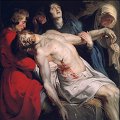 The Flemish and European
Baroque painter Peter Paul Rubens was the
most renowned northern European artist of his day, and is now widely
recognized as one of the foremost painters in Western art history. He
was the proponent of the Baroque style which emphasized
movement, color, and sensuality. By completing
the fusion of the realistic tradition of Flemish painting with the
imaginative freedom and classical themes of Italian Renaissance
painting, he fundamentally revitalized and redirected northern
European painting.
The Flemish and European
Baroque painter Peter Paul Rubens was the
most renowned northern European artist of his day, and is now widely
recognized as one of the foremost painters in Western art history. He
was the proponent of the Baroque style which emphasized
movement, color, and sensuality. By completing
the fusion of the realistic tradition of Flemish painting with the
imaginative freedom and classical themes of Italian Renaissance
painting, he fundamentally revitalized and redirected northern
European painting.
- The Union of Earth and Water (1618)
- Battle of the Amazons (1618)
- Perseus and Andromeda (1621)
- Perseus Freeing Andromeda (1622)
- The Judgment of Paris (1625)
- The Capture of Juliers (1625)
- The Landing of Marie de Medicis at Marseilles (1625)
- Simon and Pero (Roman Charity) (1630)
- Venus and Adonis (1635)
- The Consequences of War (1638)
- The Three Graces (1639)
The Union of Earth and Water (1618)
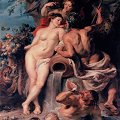 Get
Get  a high-quality picture of
The Union of Earth and Water for your computer or notebook. ‣
In the 16-17th centuries the four elements (Earth, Air, Fire and Water) are usually represented as classical gods and goddess with their attributes. Earth, as a woman has the attributes that belong to the goddesses of fertility (e.g. the cornucopia of Ceres). Water is personified by a river good with his overturned urn.
a high-quality picture of
The Union of Earth and Water for your computer or notebook. ‣
In the 16-17th centuries the four elements (Earth, Air, Fire and Water) are usually represented as classical gods and goddess with their attributes. Earth, as a woman has the attributes that belong to the goddesses of fertility (e.g. the cornucopia of Ceres). Water is personified by a river good with his overturned urn.
Battle of the Amazons (1618)
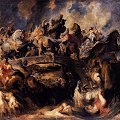 Get
Get  a high-quality picture of
Battle of the Amazons for your computer or notebook. ‣
Painted by Rubens when he was still young, the painting shows to the full the impetuosity of his talent. The whirlwind composition is typically Baroque, while the horse charging headlong into the fight was an image perfectly suited to this artist's passionate temperament.
a high-quality picture of
Battle of the Amazons for your computer or notebook. ‣
Painted by Rubens when he was still young, the painting shows to the full the impetuosity of his talent. The whirlwind composition is typically Baroque, while the horse charging headlong into the fight was an image perfectly suited to this artist's passionate temperament.
Rubens took the subject of The Battle of the Amazons from Classical Antiquity; it represents the battle between Theseus's Athenians and the women-warriors of Telestris. A battle of this kind is briefly mentioned by Herodotus (4.110). The surging movement throws the opposing forces together; men, women and horses charge into combat, and the result is like an explosion within the picture space. The Amazons are hurled from their horses down into the river at the base of the picture, while Theseus's horse rears up towards the upper frame, and the wounded go swirling into the background, drawn by the current of the River Thermodon. This is one of the most dazzling feats of Baroque painting.
Perseus and Andromeda (1621)
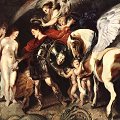 Get
Get  a high-quality picture of
Perseus and Andromeda for your computer or notebook. ‣
Ovid tells how Andromeda, daughter of an Ethiopian king, was chained to a rock by the sea-shore as a sacrifice to a sea-monster. Perseus, the son of Zeus and Danae, flying overhead, fell in love at first sight. He swooped down just in time, slew the monster and released Andromeda. He is shown, sword and shield in hand, hovering in the air near the girl. The monster approaches through the waves. The anguished parents and other onlookers stand on the shore.
a high-quality picture of
Perseus and Andromeda for your computer or notebook. ‣
Ovid tells how Andromeda, daughter of an Ethiopian king, was chained to a rock by the sea-shore as a sacrifice to a sea-monster. Perseus, the son of Zeus and Danae, flying overhead, fell in love at first sight. He swooped down just in time, slew the monster and released Andromeda. He is shown, sword and shield in hand, hovering in the air near the girl. The monster approaches through the waves. The anguished parents and other onlookers stand on the shore.
Perseus Freeing Andromeda (1622)
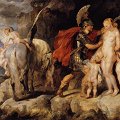 Get
Get  a high-quality picture of
Perseus Freeing Andromeda for your computer or notebook. ‣
Chained to a rock, Andromeda, daughter of the King of Ethiopia, was to be sacrificed to a sea-monster. The king had been ordered to make this sacrifice, in order to make amends for the arrogance of his wife, Cassiopeia. As Perseus, who had vanquished the dreaded Gorgon Medusa, was returning home on his winged horse, Pegasus, he caught sight of the chained Andromeda and delivered her from the threat of the monster. Overcome by the beauty of the young princess, her liberator confessed his love: 'Oh, thou deservest not chains such as these but only the bonds that unite passionate lovers' (Ovid).
a high-quality picture of
Perseus Freeing Andromeda for your computer or notebook. ‣
Chained to a rock, Andromeda, daughter of the King of Ethiopia, was to be sacrificed to a sea-monster. The king had been ordered to make this sacrifice, in order to make amends for the arrogance of his wife, Cassiopeia. As Perseus, who had vanquished the dreaded Gorgon Medusa, was returning home on his winged horse, Pegasus, he caught sight of the chained Andromeda and delivered her from the threat of the monster. Overcome by the beauty of the young princess, her liberator confessed his love: 'Oh, thou deservest not chains such as these but only the bonds that unite passionate lovers' (Ovid).
Rubens knew how to translate the popular, widely-known poetry of Ovid into his own special language. On a sea-girt spur of rock Perseus steps towards the royal princess. Dressed in gleaming armour and in the red cloak of the conqueror, he loosens the chains binding the naked maiden, who stands with downcast eyes. Two putti, who, to the best of their ability, are lending a hand, also seem not uninterested in the human side of the encounter; three others are attending to the winged, dapple-grey horse, which is impatiently pawing the rock with its hoof. In the depths of the blue sea the winding coils of the monster appear.
Many pictorial themes in Flemish Baroque painting, particularly that of the humanist and diplomat Rubens, are by no means confined to depicting events. The story of Andromeda, for example, was also given political significance, and this kind of material, as an allegory of oppression and liberation in the struggle against enemy powers, was open to a great variety of interpretations. Indeed, the Berlin picture was painted at practically the same time as Rubens' most important work in the field of political allegory, the great cycle of wall-paintings commissioned by Marie de Medicis in Paris in 1622.
Rubens treated the same theme in a picture of similar size and design, now in the Hermitage in St. Petersburg.
The Judgment of Paris (1625)
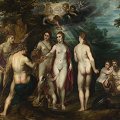 Get
Get  a high-quality picture of
The Judgment of Paris for your computer or notebook. ‣
The Judgment of Paris (the son of a Trojan king, Priam) is the most popular of all mythological themes in art. The scene depicts the story of his award of the golden apple to Venus in a contest of beauty between her, Juno, and Minerva. Rubens painted several versions of the subject.
a high-quality picture of
The Judgment of Paris for your computer or notebook. ‣
The Judgment of Paris (the son of a Trojan king, Priam) is the most popular of all mythological themes in art. The scene depicts the story of his award of the golden apple to Venus in a contest of beauty between her, Juno, and Minerva. Rubens painted several versions of the subject.
The Capture of Juliers (1625)
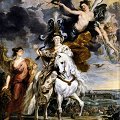 Get
Get  a high-quality picture of
The Capture of Juliers for your computer or notebook. ‣
Certainly, it was not the rather heavy features of the Medici family, particularly evident in the queen, that had attracted Henri IV, but the scale of her dowry. Rubens nevertheless contrived to render her portrait agreeable. He disguised her now as an attractive Bellona, now as a proud horsewoman in The Capture of Juliers. The royal couple become Olympian deities in The Meeting of Marie de Medicis and Henri IV at Lyon, while The Fate Spinning Marie's Destiny and The Triumph of Truth became pretexts for a proliferation of female convexity.
a high-quality picture of
The Capture of Juliers for your computer or notebook. ‣
Certainly, it was not the rather heavy features of the Medici family, particularly evident in the queen, that had attracted Henri IV, but the scale of her dowry. Rubens nevertheless contrived to render her portrait agreeable. He disguised her now as an attractive Bellona, now as a proud horsewoman in The Capture of Juliers. The royal couple become Olympian deities in The Meeting of Marie de Medicis and Henri IV at Lyon, while The Fate Spinning Marie's Destiny and The Triumph of Truth became pretexts for a proliferation of female convexity.
The Landing of Marie de Medicis at Marseilles (1625)
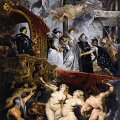 Get
Get  a high-quality picture of
The Landing of Marie de Medicis at Marseilles for your computer or notebook. ‣
Thanks to his organisational capacities, Rubens could meet demand and revolutionise the problem of large-scale pictorial decoration. His renown extended well beyond the frontiers of his country, and in 1621 Marie de Medicis, widow of Henri IV of France and mother of the reigning king Louis XIII, invited him to Paris. She wished him to decorate one of the galleries of the newly built Palais de Luxembourg with 24 monumental paintings commemorating episodes in the lives of herself and her renowned husband. The creation of a cycle of tapestries had, in a sense, been Rubens' technical apprenticeship for this demanding task, the composition of a cycle of vast narrative paintings dedicated to a living queen who had already entered history.
a high-quality picture of
The Landing of Marie de Medicis at Marseilles for your computer or notebook. ‣
Thanks to his organisational capacities, Rubens could meet demand and revolutionise the problem of large-scale pictorial decoration. His renown extended well beyond the frontiers of his country, and in 1621 Marie de Medicis, widow of Henri IV of France and mother of the reigning king Louis XIII, invited him to Paris. She wished him to decorate one of the galleries of the newly built Palais de Luxembourg with 24 monumental paintings commemorating episodes in the lives of herself and her renowned husband. The creation of a cycle of tapestries had, in a sense, been Rubens' technical apprenticeship for this demanding task, the composition of a cycle of vast narrative paintings dedicated to a living queen who had already entered history.
Giving epic treatment to this biographical subject, Rubens was also able to give free rein to his fertile invention. He prepared two series of oil sketches, with detailed figures drawn in, which it then fell to his assistants to scale up to the dimensions of the canvases commissioned. These were then meticulously retouched by the master so that they might be ultimately be described, at least in the final layers of paint, as his own works. The entire commission was completed in only three years.
All of his prodigious culture was drawn on for these works: his encyclopaedic knowledge of classical mythology was exploited to the full in transforming the queen's entire career - Henri slipped rather into the background - into a kind of operatic sequence largely of Rubens' own invention. Metamorphosing life into myth, he freely mingled historical personages with the gods of Olympus, who came to represent them. The scheme of this apparatus was invented as he went along, the - often gratuitous - interpolations of the divine gracefully leavening the uneventful royal life. It had required all of Rubens' imaginative resources and natural verve to ennoble and illustrate the relatively colourless circumstances of the Queen Mother's life. These qualities were essential; Rubens' international renown depended on his success in this formidable commission. His solution was to populate his compositions with nude goddesses, pagan gods, curvaceous undines, mischievous tritons, and genii unspecified. His customary contrasts are at work in the playful opposition of gleaming cuirasses and lusty bodies, fragile silks and the rugged hulls of dreadnoughts. The poverty of his subject was utterly transcended; this is pure painting, nothing but painting.
Certainly, it was not the rather heavy features of the Medici family, particularly evident in the queen, that had attracted Henri IV, but the scale of her dowry. Rubens nevertheless contrived to render her portrait agreeable. He disguised her now as an attractive Bellona, now as a proud horsewoman in The Capture of Juliers. The royal couple become Olympian deities in The Meeting of Marie de Medicis and Henri IV at Lyon, while The Fate Spinning Marie's Destiny and The Triumph of Truth became pretexts for a proliferation of female convexity.
Simon and Pero (Roman Charity) (1630)
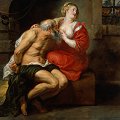 Get
Get  a high-quality picture of
Simon and Pero (Roman Charity) for your computer or notebook. ‣
Of the examples of 'filial piety' in the literature of antiquity, that of Cimon and Pero was one of the ones that appealed most to artists of the 16th to 18th centuries in Italy and the Netherlands. Valerius Maximus tells of a certain Cimon, an aged man, who was in prison awaiting execution and who was therefore given no food. The jailer allowed Cimon's daughter Pero to visit him. She nourished him by giving him her breast. The scene is a prison cell; the white-haired prisoner, manacled, reclines in the lap of a young woman who is suckling him. A jailer peers through a barred window.
a high-quality picture of
Simon and Pero (Roman Charity) for your computer or notebook. ‣
Of the examples of 'filial piety' in the literature of antiquity, that of Cimon and Pero was one of the ones that appealed most to artists of the 16th to 18th centuries in Italy and the Netherlands. Valerius Maximus tells of a certain Cimon, an aged man, who was in prison awaiting execution and who was therefore given no food. The jailer allowed Cimon's daughter Pero to visit him. She nourished him by giving him her breast. The scene is a prison cell; the white-haired prisoner, manacled, reclines in the lap of a young woman who is suckling him. A jailer peers through a barred window.
Venus and Adonis (1635)
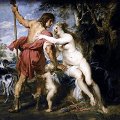 Get
Get  a high-quality picture of
Venus and Adonis for your computer or notebook. ‣
The story, which has attracted not only artists but poets, including Shakespeare, tells that Adonis was the offspring of the incestuous union of King Cinyras of Paphos, in Cyprus, with his daughter Myrrha. His beauty was a byword. Venus conceived a helpless passion for him as a result of a chance graze she received from Cupid's arrow (Ovid: Metamorphoses). One day while out hunting Adonis was slain by a wild boar, an accident Venus had always dreaded. Hearing his dying groans as she flew overhead in her chariot, she came down to aid him but was too late. In the place where the earth was stained with Adonis' blood, anemones sprouted.
a high-quality picture of
Venus and Adonis for your computer or notebook. ‣
The story, which has attracted not only artists but poets, including Shakespeare, tells that Adonis was the offspring of the incestuous union of King Cinyras of Paphos, in Cyprus, with his daughter Myrrha. His beauty was a byword. Venus conceived a helpless passion for him as a result of a chance graze she received from Cupid's arrow (Ovid: Metamorphoses). One day while out hunting Adonis was slain by a wild boar, an accident Venus had always dreaded. Hearing his dying groans as she flew overhead in her chariot, she came down to aid him but was too late. In the place where the earth was stained with Adonis' blood, anemones sprouted.
Rubens depicts the scene when Adonis, spear in hand and with hunting dogs straining at the leash, is impatient to be off, while Venus imploringly tries to hold him back. But she pleads in vain. The painting is a variation on a picture painted by the master Rubens most revered: Titian. In Rubens' painting, Venus became the goddess by whom he himself now steered, Helena Fourment, while the fate of Adonis is implicit in the painting's elegiac tone. The nude Venus, grace- fully seated, begs Adonis to remain, gently coaxing the garment from his shoulder. She casts a beseeching glance at him, her anxiety translated in the disorder of her blonde tresses. The tanned and muscular Adonis is clothed in a dazzling red tunic prefiguring the flower that he is to become; he is the incarnation of a Greek statue, his body standing out against the luminous sky that Venus has abandoned for love of him. At his feet, a little Cupid pleadingly clasps one of his thighs; the presence of the god of love and his quiver evokes the first cause of this tragic encounter. But for the duration of the moment, it is love rather than tragedy that prevails. Thus Rubens transforms the Metamorphoses themselves into a symbol of marital love.
Rubens was a devout Roman Catholic, yet his paintings while religious in theme were not influenced by the dogma of his era. He interjected a lusty exuberance into his work rather than staying strictly to his academic, traditional forms. This painting was completed near the end of his life at a time when he struggled with arthritis almost daily.
The Consequences of War (1638)
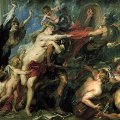 Get
Get  a high-quality picture of
The Consequences of War for your computer or notebook. ‣
Rubens painted the Consequences of War (or Horrors of War) for Ferdinand de' Medici, grand duke of Tuscany. This picture in a certain sense is the negative counterpart of the allegory on peace painted for Charles I, king of England. The message of this painting is exceptionally pessimistic: even love cannot restrain the blind martial brutality of the Thirty Years War from plunging Europe into mourning and destroying her prosperity. Yet this did not prevent Rubens portraying this tragic subject in the most Titianesque spirit, as a perfect demonstration of chromatic harmony.
a high-quality picture of
The Consequences of War for your computer or notebook. ‣
Rubens painted the Consequences of War (or Horrors of War) for Ferdinand de' Medici, grand duke of Tuscany. This picture in a certain sense is the negative counterpart of the allegory on peace painted for Charles I, king of England. The message of this painting is exceptionally pessimistic: even love cannot restrain the blind martial brutality of the Thirty Years War from plunging Europe into mourning and destroying her prosperity. Yet this did not prevent Rubens portraying this tragic subject in the most Titianesque spirit, as a perfect demonstration of chromatic harmony.
The Three Graces (1639)
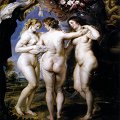 Get
Get  a high-quality picture of
The Three Graces for your computer or notebook. ‣
The Three Graces is one of the artist's final works. He had portrayed this theme several times since about 1620, but only later adopted the form that prevailed in classical Antiquity, with the three figures forming a circle so that one of them has her back to the spectator. "They were the goddesses of pleasant charm, of charitable deeds and of gratitude... without them nothing would be graceful or pleasing. They gave people friendliness, uprightness of character, sweetness and conversation...They were presented as three beautiful virgins and were either completely naked or clothed in some fine, transparent fabric...They stood together all three so that two of their faces were turned towards the spectator and only one was turned away from him."
a high-quality picture of
The Three Graces for your computer or notebook. ‣
The Three Graces is one of the artist's final works. He had portrayed this theme several times since about 1620, but only later adopted the form that prevailed in classical Antiquity, with the three figures forming a circle so that one of them has her back to the spectator. "They were the goddesses of pleasant charm, of charitable deeds and of gratitude... without them nothing would be graceful or pleasing. They gave people friendliness, uprightness of character, sweetness and conversation...They were presented as three beautiful virgins and were either completely naked or clothed in some fine, transparent fabric...They stood together all three so that two of their faces were turned towards the spectator and only one was turned away from him."
Rubens' late painting of three nude figures magnificently illustrates the artist's extraordinary handling of incarnate or human flesh tones. Rubens builds them up using the three primary colours yellow, red and blue. An unusually high proportion of blue is evident here. In this way, the human figure bears the same primary colours that make up the appearance of the world and the entire cosmos, and all that is gathered here in the landscape and flowers, the sky and the trees.
Peter Paul Rubens Art
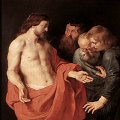
|
|
More
Articles
 Art Encyclopedia A world history of art in articles.
Art Encyclopedia A world history of art in articles.
Baroque
Peter Paul Rubens
Art and life. Biography.
Early mythological paintings.
Late mythological paintings.
Early religious paintings.
Late religious paintings.
Portraits.
Landscapes.
Art
 Art Wallpapers Art image collections for your desktop.
Art Wallpapers Art image collections for your desktop.
Caravaggio Art, $25
(100 pictures)
Rubens Art, $29
(200 pictures)
Rembrandt Art, $25
(160 pictures)

